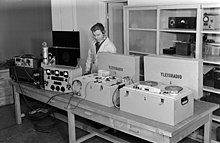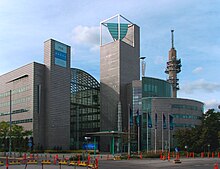Yle
 Logo used since 2012 | |
| Type | Terrestrial radio, television and online |
|---|---|
| Branding | Yleisradio |
| Country | |
First air date | 1926 |
| Availability | Finland (and also parts of Sweden, Norway, Russia and Estonia) |
| Founded | 29 May 1926 (Radio) 1 January 1958 (Television) |
| 45.2% of Finnish television viewers and 53% of radio listeners (2010)[1][2] | |
| Headquarters | Helsinki, Finland |
| Regions | YLE Åland |
| Owner | 99.98% state-owned, supervised by an Administrative Council appointed by Parliament |
| Parent | Ministry of Transport and Communications |
Key people | Merja Ylä-Anttila (CEO) |
Launch date | 9 September 1926 |
Former names | O.Y. Suomen Yleisradio / A.B. Finlands Rundradio[3] |
Official website | yle |
Yleisradio Oy (lit. 'General Radio Ltd.'; Swedish: Rundradion Ab), abbreviated as Yle (Finnish pronunciation: [ˈyle]) (formerly styled in all uppercase until 2012), translated into English as the Finnish Broadcasting Company, is Finland's national public broadcasting company, founded in 1926. It is a joint-stock company, which is 99.98% owned by the Finnish state and employs around 3,200 people in Finland. Yle shares many of its organisational characteristics with its British counterpart, the BBC, on which it was largely modelled.
Yle was long funded by revenues obtained from a broadcast receiving license fee payable by the owners of radio sets (1927–1976) and television sets (1958–2012) and through a portion of the broadcasting license fees payable by private television broadcasters. Since 2013, the license fee has been replaced by a public broadcasting tax (known as the Yle tax) collected annually from Finnish citizens and corporations.
The main part of the Yle tax is collected from individual taxpayers, with payments assessed on a sliding scale. Minors and those with an annual income less than €7,813 are exempt. At the lower limit, the tax payable by individuals is €50 per annum, and the maximum (payable by an individual with a yearly income of €20,588 or more) is €140.[4] The rationale for the abolition of the television license fee was the development of other means of delivering Yle's services, such as the Internet, and the consequent impracticality of continuing to tie the fee to the ownership of a specific device. Yle receives no advertising revenue, as all channels are advertisement-free.
Yle has a status that could be described as that of a non-departmental public body. It is governed by a parliamentary governing council. Yle's turnover in 2010 was €398.4 million. In 2022, Yle's annual budget was about €560 million.[5]
Yle operates three national television channels, 13 radio channels and services, and 25 regional radio stations. As Finland is constitutionally bilingual—around 5.5% of the population speaks Swedish as their native language—Yle provides radio and TV programming in Swedish through its Swedish-language department, Svenska Yle. As is customary in Finland, foreign films and TV programmes (as well as segments of local programmes that feature foreign language content, like news reports) are generally subtitled on Yle's channels. Dubbing is used in cartoons intended for young children who have not yet learned to read; off-screen narration in documentaries is also frequently dubbed.[citation needed]
In the field of international broadcasting, one of Yle's best-known services was Nuntii Latini, the news in Latin, which was broadcast worldwide and made available on the Internet.
Yle was one of 23 founding broadcasting organisations of the European Broadcasting Union in 1950. It hosted the Eurovision Song Contest 2007 in Helsinki.
History
[edit]This section needs expansion. You can help by adding to it. (August 2017) |




Suomen Yleisradio (Finland's General Radio) was founded in Helsinki on 29 May 1926. The first radio programme was transmitted on 9 September that year in a studio at Unioninkatu 20, generally considered the birthdate of regular broadcasting activities in Finland. The name Yleisradio was taken from the Defense Forces, where Yleisradio meant a radio broadcast that could be heard by everyone.[6] Before YLE, Radio broadcasts were done by Radiola in Helsinki from March 23, 1924,[7] the radio battalion of the Finnish Defense Forces in Santahamina at the former Russian Empire Baltic Fleet officer casino, now Katajanokka casino starting in April 1923[8] and by Tampereen radioyhdistys, (Tampere Radio Society) in April 1924.[9] Not until 1928 did Yle's broadcasts become available throughout the country. By the beginning of the 1930s, 100,000 households could listen to Yle programmes, and in 1933, Yle moved to Fabianinkatu 15, were it would stay until 1968 were it moved to Ylen Kesäkatu and then Mediatalo in 1978.
In 1957, Yle made its first television broadcast tests, and regular TV programming began the next year under the name Suomen Televisio (Finland's Television), which was later renamed Yle TV1. Television's popularity in the country grew rapidly. In 1964, Yle obtained TES-TV and Tamvisio, which were merged into Yle TV2. In 1969, the Finnish Broadcasting Company began broadcasting television programmes in colour, but due to the high cost of colour technology, colour only became standard in the late 1970s. On 1 May 1977, Tv-uutiset (TV-news) and TV-nytt switched to colour.
In 1996, Yle's operations in the Åland Islands were transferred to Ålands Radio and TV, and in 1998, Yle's transmitter network and related assets were spun off into a separate company called Digita Oy.
In the 2000s, Yle established several new radio and television channels. In 2007, there was a digital television switchover. A completely new digital channel, Yle Teema (Yle Theme) was introduced, and the Swedish-language FST (Finlands Svenska Television, Finland's Swedish Television) was moved from its analogue channel to its digital one, YLE FST5 (later renamed Yle Fem). In addition to these four channels (TV1, TV2, Teema, and Fem), a fifth channel, YLE24, was launched in 2001 for 24-hour news programming. This channel was replaced by YLE Extra, a channel attempting to cater to the youth, which was in turn decommissioned in 2007.[10] Until 4 August 2008, the fifth channel was used to broadcast Yle TV1 with Finnish subtitles on programmes in foreign languages (without having to enable the TV's or digital set-top box's subtitle function).
Logo history
[edit]-
Yle's first logo was used from 1926 to 1940.
-
Yle's second logo used from 1940 to 1965. Yle Radio Suomi used a modified version of this logo from 2010–12.
-
Yle's third logo used from 1965 to 1991.
-
Yle's fourth logo used from May 1990 to 30 September 1999.
-
Yle's fifth logo used from 1 October 1999 to 4 March 2012.
-
Yle's sixth and current logo since 5 March 2012.
-
Variant of Yle's sixth and current logo since 5 March 2012.
Services
[edit]Television
[edit]
- Yle TV1: TV1 is Yle's oldest channel and its flagship TV channel. It serves as Yle's main news, current affairs and factual journalism outlet, and also broadcasts documentaries, drama, cultural, and educational programmes. Satirical entertainment, cinema, and shows of British production are also included in its programming. The channel's headquarters are in Helsinki.
- Yle TV2: TV2, founded in 1964, is the main channel for sports programmes and children's and teenagers' broadcasting. The channel also broadcasts drama, entertainment, and factual programmes. Emphasis in current affairs output is on domestic items, regional content and citizen journalism. Children's programming includes Pikku Kakkonen (a children's magazine show modelled on BBC's Blue Peter) and Galaxi, its counterpart for older children, and Sirkuspelle Hermanni. The channel's headquarters are in Tampere.
- Yle Teema & Fem: Yle Teema & Fem (~ Yle Theme & Five) combines the operations of the previously separate Teema and Fem channels. Teema & Fem is Yle's channel for culture, education, and science. It focuses on recordings of performing arts, classical music, art, and history documentaries, films, and theme broadcasts. The channel also broadcasts Swedish-language full-service channel broadcasting news, factual and children's programmes, and entertainment. It also shows many Nordic films and series and Sami-language Ođđasat. Finnish subtitles are available for most programmes; they can be enabled using the digital set-top box. Outside prime time, Teema & Fem shows selected broadcasts from Sveriges Television, Sweden's equivalent of Yle.
- TV Finland: TV Finland is a digital satellite channel showing a selection of Yle's programmes in Sweden.
- Yle Text-TV: (Finnish: Yle Teksti-tv) a Teletext channel shows information on news, sports, and TV programmes around the clock. It has theme pages for weather, traffic, work, and leisure.[12]
As of January 2014, all of Yle's TV channels except TV Finland are available in high definition. [citation needed] Former, discontinued, channels are Kolmoskanava, YLE24, YLE Extra, YLE TV1+ (2008) and YLE HD (2011–2014).
Radio
[edit]
- Yle Radio 1: A radio channel for culture, in-depth current affairs, and other speech-based programming. Classical music (concerts by the Finnish Radio Symphony Orchestra), jazz, folk, world music, and religious music also feature. Yle Radio 1 was established in June 1990, as part of Yle's restructuring of its radio channels and was known as Radio Ylen Ykkönen until 2003.
- YleX (formerly Radiomafia): A fast-tempo programme-flow channel featuring new music in tune with popular culture, targeted at 17- to 27-year-olds. The percentage of music is 70%. New domestic and foreign pop, rock, and several themed music programmes.
- Yle Radio Suomi: The national and regional news, service, and contact channel, as well as sports and entertainment. Musical fare comprises domestic and foreign hits and adult and nostalgic pop.
- Yle X3M: Swedish-language youth channel for current affairs debate and popular culture, broadcasting news as well. New pop and rock and special music programmes.
- Yle Vega: News, current affairs, and culture in Swedish for all audience groups, also offering culture and regional programmes. Adult pop, jazz, and classical music.
- Yle Sámi Radio: A Sami-language network covering most of Lapland. Produced in co-operation with SVT and NRK.
- Digital services
Yle phased out digital audio broadcasts by the end of 2005. Three channels continued to be available as DVB audio services until they were shut down on 30 June 2016.
- Yle Klassinen: The 24-hour digital supplementary service of classical music is also broadcast on digital television.
- International services
- Yle Mondo: Broadcasts in English and other languages, mostly compiled from international radio services. Yle Mondo is available on FM in Helsinki and throughout the country via digital TV.
- Former stations
- YleQ – Features, political shows, and popular culture programmes for young adults. Broadcasting was analogue in the greater Helsinki area, digital in southern Finland, and via digital television.
- Radio Finland (worldwide on short and medium wave) – international station, broadcast in Finnish, Swedish, English, German, French, Russian and a news programme in Latin. The short and medium-wave broadcasts were discontinued on December 31, 2006.
- YLE Capital FM – broadcaster combined parts of Yle World and Yle Mondo (in the capital region and parts in Turku, Lahti and Kuopio).
- FSR Mixkanalen or Finland's Swedish Radio (FSR) – an automated station that broadcasts a mixed selection of programming from both Yle Vega and Yle XFM.[13]
- Radio Aino – digital station primarily aimed at young adults, especially women, with domestic and foreign pop and rock music, news and current affairs programming alongside lifestyle talk shows.
- Yle Puhe (formerly Yle Radio Peili): The news and current affairs channel presenting talk programmes from Yle's other radio and television channels. Classical jazz. Also broadcast on digital television.
Yle tax
[edit]Until the end of 2012, Finnish citizens paid Yle a license fee for the use of a television, set at 252 euros per year in 2012. The license fee was per location, which could hold several sets (e.g. in a living room as well as a bedroom). The public broadcasting tax, also known as the Yle tax, replaced the license fee in 2013. The tax ranges from 50 euros to 140 euros per person and per year, depending on income. Minors and persons with low income are exempt from the tax.[14]
Controversies
[edit]This article needs additional citations for verification. (July 2011) |
In radio, Yle was a legal monopoly until 1985, when local radio stations were permitted, and maintained a national monopoly until 1995, when national radio networks were allowed.
In the past, Yle has been seen in Finland as a "red" or leftist medium. This was true especially in 1965–69, during the term of Director-General Eino S. Repo, who got the position with the backing of the Agrarian League and President Kekkonen (a member of the Agrarian Party), as he was Kekkonen's personal friend. He was accused of favouring leftist student radicalism and young, left-leaning reporters with programmes critical of capitalism that demanded reforms to bring Finland closer to the Soviet Union, and Yle was given the nickname "Reporadio". After Repo resigned, he was demoted to director of radio broadcasting, on the communist-led People's Democratic League mandate.
Repo resigned in 1969, but according to Yle,[15] the "political mandate" remained, as Erkki Raatikainen was named director directly from the Social Democratic Party office. All directors after him until 2010 were Social Democrats. This was ended by the appointment of the right-wing National Coalition Party's Lauri Kivinen as director in 2010.
During Finlandisation and the leftist radicalization of the 1970s, Yle contributed to Kekkonen's policy of "neutrality" by broadcasting the program Näin naapurissa about the Soviet Union. This program was produced in cooperation with the Soviets and supported Soviet propaganda without criticism.[16]
Kivinen's appointment in 2010 received much criticism, as he was previously head of Nokia Siemens Networks, which had sold monitoring equipment to the Iranian Ministry of Intelligence, allowing them to arrest political dissidents throughout the protests in the fall of 2009.[17]
English-language newscaster Kimmo Wilska was fired on 13 October 2010[18] after pretending to be caught drinking on camera following an alcohol-related news story on Yle News. His stunt was not well received by Yle management, which fired him that day. Wilska received substantial support after his termination.
Yle has been criticised for buying many HBO series. It has responded by emphasising the suitability of series to channels with no ad breaks, citing HBO programming's quality and low price, and stating that American programmes constitute only 7% of its programming.[19]
Decision to close shortwave
[edit]The broadcasts on shortwave from Yle Radio Finland were closed at the end of 2006. Expatriate organisations had been campaigning for continued service, but their efforts did not succeed in maintaining the service or even in slowing the process. The decision also affected a high-powered medium wave on 963 kHz (312m). A smaller medium wave covering the Gulf of Finland region (558 kHz, 538m) remained on air for one more year.
Parliamentary question about shortwave
[edit]In November 2005, MP Pertti Hemmilä (N) submitted a question in Parliament about the plans of Yle to end its availability on international shortwave bands. In his question, Hemmilä took up the low cost of the world band radio to the consumer travelling or living abroad. In her response, the Minister of Transport and Communications, Susanna Huovinen (S) noted that Yle would now be available via other means, such as satellites and the Internet. She also underlined the fact that Yle is not under government control, but under indirect parliamentary supervision.[20]
YLE Gate 2017
[edit]The Council for Mass Media in Finland criticized Yleisradio for restricting news reports about Prime Minister Juha Sipilä's investments and business in 2017. The chief editor of Yle threatened that Yle would resign from the Council. PM Sipilä had been angry over Yle's reports on the Talvivaara mine and Katera Steel (a company owned by relatives of Sipilä). Several reporters were barred from publishing stories about political connections between Sipilä and companies owned by his relatives, and state financing of the Talvivaara mine (Terrafame mine).[21]
List of YLE directors
[edit]- L. M. Viherjuuri, 1926–1927 (acting)
- Yrjö Koskelainen, 1927 (acting)
- Armas Deinert, 1927 (acting)
- Hjalmar Woldemar Walldén (since 1935 Jalmar Voldemar Vakio) 1927–1945
- Hella Wuolijoki, 1945–1949
- Einar Sundström, 1950–1964
- Eino S. Repo, 1965–1969
- Erkki Raatikainen, 1970–1979
- Sakari Kiuru, 1980–1989
- Reino Paasilinna, 1990–1994
- Arne Wessberg, 1994–2005
- Mikael Jungner, 2005–2010
- Lauri Kivinen, 2010–2018
- Merja Ylä-Anttila, 2018–in office
Notable news anchors
[edit]- Marjo Rein
- Matti Rönkä
- Tommy Franti
- Jussi-Pekka Rantanen
- Arto Nurmi
- Marjukka Havumäki
- Piia Pasanen
See also
[edit]References
[edit]- ^ "Results From The TV Audience Measurement". Finnpanel. Retrieved 23 December 2011.
- ^ "Radio Listening In Finland 2010" (PDF). Finnpanel. 3 February 2011. p. 18. Archived (PDF) from the original on 27 May 2012. Retrieved 23 December 2011.
- ^ "Ylen historia". yle.fi. 11 January 2015.
- ^ "Yle tax in force next year". yle.fi. 21 June 2012. Retrieved 6 February 2013.
- ^ "Yleisradio – yle.fi". yle.fi. Archived from the original on 3 December 2013. Retrieved 27 November 2013.
- ^ "Sinko, Säteisheitin vai Yle?". yle.fi (in Finnish). 27 September 2013. Retrieved 22 October 2024.
- ^ "elokuuta 1924 Radio no 2, s. 19". digi.kansalliskirjasto.fi (in Finnish). Retrieved 22 October 2024.
- ^ "Helsingin venäläiset varuskuntarakennukset 1917 ja suomalainen varuskunta 1918". itsenäisyys.fi. Retrieved 27 November 2024.
- ^ "KOSKESTA VOIMAA - LIIKKUMINEN - AIKAKAUSI 1918-1940 - TIETOLIIKENNE - RADIOTOIMINNAN SYNTY TAMPEREELLA". webpages.tuni.fi. Retrieved 22 October 2024.
- ^ "Yle lopettaa yhden tv-kanavan". mtv.fi (in Finnish). Archived from the original on 21 March 2018. Retrieved 21 March 2018.
- ^ Tuire, Nuolivirta. ""Yleisradion logot kautta aikojen"" (PDF). avoinyle.fi. Archived from the original (PDF) on 1 August 2013. Retrieved 4 April 2024.
- ^ "Yle Teksti-tv". Yle. Retrieved 10 August 2015.
- ^ "FSR:s mixkanal läggs ned". 24 August 2005.
- ^ "New YLE tax law causes mixed feelings". Helsinki Times. 4 July 2012. Retrieved 29 June 2014.
- ^ "Elävä arkisto - yle.fi". yle.fi.
- ^ Jukka Lindfors (5 September 2008). "Näin naapurissa". yle.fi.
- ^ "Helsingin Sanomat - International Edition - Home". hs.fi. Archived from the original on 9 March 2010.
- ^ Petra Himberg. "Kohuankkuri Kimmo Wilska". yle.fi. Archived from the original on 17 October 2010. Retrieved 7 April 2011.
- ^ "Why public service company wastes money on HBO programs? (in Finnish)". Yle. Retrieved 6 February 2013.
- ^ Recollections of international radio from Finland "On the air waves from Finland". www.ulkomaanmedia.net. Archived from the original on 23 April 2009. Retrieved 19 April 2008.
- ^ Mitä Missä Milloin. 2018 Annual News Book. Otava 2017. pages 109 and 341-342
External links
[edit]- Official website (in Finnish)
- About Yle in English
- Svenska.yle.fi – Svenska Yle. Official site in Swedish
- Yle News – News in English
- Yle Sápmi – News in Sámi
- Yle Novosti – News in Russian
- Nuntii Latini – News in Latin
- Yle Areena – in Finnish
- Yle Arenan – in Swedish
- Yle Elävä arkisto – the Living Archive in Finnish
- Yle Arkivet – the Archive in Swedish
- Yle
- Publicly funded broadcasters
- European Broadcasting Union members
- Commercial-free television networks
- Mass media companies of Finland
- Radio stations established in 1926
- Television in Finland
- Companies based in Helsinki
- State media
- 1926 establishments in Finland
- Finnish news websites
- Defunct shortwave radio stations
- YouTube channels launched in 2005





